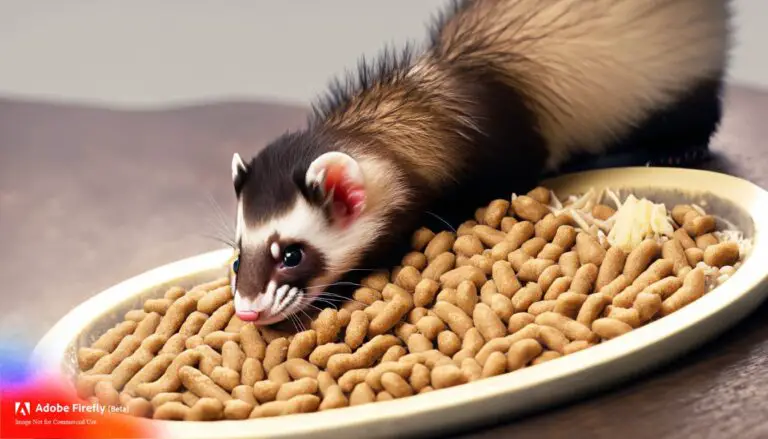
Hey there, fellow ferret enthusiasts! If you’ve ever come across a ferret sporting an adorable eye patch, you might be wondering what could be the reason behind it. Well, you’ve come to the right place! In this article, I’ll be diving into the fascinating world of ferrets with eye patches, exploring the possible reasons behind this unique phenomenon and sharing some helpful tips on how to take care of your little pirate pal.
You might be thinking, “Why do some ferrets need an eye patch in the first place?” Don’t worry, I’ve got you covered. While it may seem unusual, there are actually a few reasons why a ferret might be rocking an eye patch. From injuries and infections to congenital conditions, there are various factors that can lead to this eye-catching accessory. But fear not, my friends, for I’ll be shedding light on each of these reasons and providing you with valuable insights on how to handle them.
Reasons for Ferrets to Wear Eye Patches
There are several reasons why a ferret might need to wear an eye patch. Let me explain each of these reasons in detail:
- Injuries: Ferrets, just like any other pets, can be prone to injuries. They are curious and energetic creatures, and accidents can happen. A ferret with an eye injury or a scratch to the eye might require an eye patch to protect the affected area and promote healing.
- Infections: Ferrets are susceptible to eye infections, which can be caused by bacteria or viruses. These infections may lead to redness, swelling, discharge, and discomfort. In some cases, wearing an eye patch can help prevent further irritation and minimize the spread of infection.
- Congenital Conditions: Some ferrets are born with congenital eye conditions that may require them to wear an eye patch. These conditions can include issues with the eyelids, tear ducts, or abnormalities in the eye structure. Wearing an eye patch can help manage these conditions and provide support to the affected eye.
It’s important to note that if your ferret is wearing an eye patch, it is best to consult with a veterinarian to determine the underlying cause and appropriate treatment. Do not attempt to diagnose or treat your ferret’s eye condition without professional guidance.
Now that you understand the reasons why a ferret might need to wear an eye patch, let’s move on to the next section where I’ll provide some tips on how to take care of a ferret with an eye patch.
1. Injuries
When it comes to ferrets, they can be quite mischievous and prone to accidents. As a result, injuries are a common occurrence that may require the use of an eye patch.
Ferrets are naturally curious and agile animals, and their playful nature can sometimes lead to accidents. They may inadvertently scratch or injure their own eye while roughhousing or exploring their surroundings. Injuries can range from minor scratches to more serious wounds that require immediate attention.
In such cases, wearing an eye patch can help protect and promote healing. The eye patch acts as a barrier, preventing further injury or irritation to the affected eye. It also allows the eye to rest and heal without any additional strain or exposure to potential irritants.
If you notice any signs of injury, such as swelling, redness, discharge, or a change in your ferret’s behavior, it’s crucial to seek veterinary care. A veterinarian will be able to assess the severity of the injury and recommend the appropriate course of treatment, which may include the use of an eye patch.
To properly care for a ferret with an eye patch due to an injury, follow these tips:
- Keep the eye patch clean and in good condition. Regularly check for any signs of wear or damage that may require replacement.
- Administer any prescribed medication according to the veterinarian’s instructions.
- Minimize activities that could further aggravate the injury, such as excessive play or rough handling.
- Provide a comfortable and quiet environment for your ferret to rest and recover.
- Regularly monitor the eye’s progress and consult with your veterinarian for any concerns or changes in your ferret’s condition.
Remember, early detection and prompt treatment of injuries can help ensure a speedy recovery. Don’t hesitate to reach out to your veterinarian if you notice any signs of eye injury in your ferret.
2. Infections
Eye infections in ferrets can be a common occurrence, and wearing an eye patch can sometimes be necessary to prevent further irritation and minimize the spread of infection. As a ferret owner, it’s essential to understand the reasons behind these infections and how to care for your furry friend if they have one.
Common causes of eye infections in ferrets:
- Bacterial infections: Ferrets are susceptible to bacterial eye infections, which can occur due to various factors such as poor hygiene, injury, or a weak immune system. These infections can lead to redness, swelling, discharge, and discomfort for your ferret.
- Viral infections: Viruses like the influenza virus and the coronavirus can also cause eye infections in ferrets. These infections may present with symptoms such as watery eyes, sneezing, and nasal discharge.
Taking care of a ferret with an eye infection:
If your ferret is diagnosed with an eye infection, it’s crucial to closely follow the veterinarian’s advice and treatment plan. Here are some tips to help you care for your furry companion:
- Administer prescribed medication: Follow the veterinarian’s instructions on how to properly administer any prescribed eye drops or medications. It’s important to be consistent and ensure that your ferret receives the appropriate dosage.
- Keep the eye patch clean: If an eye patch is prescribed to protect the infected eye, make sure to keep it clean to prevent further contamination. Gently clean the eye patch with a mild, non-irritating cleanser as per your veterinarian’s recommendation.
- Minimize activities that could aggravate the infection: Infections can be exacerbated by rubbing or scratching the eye. Keep a close eye on your ferret and discourage any behavior that might irritate the infected eye.
- Provide a comfortable environment for rest and recovery: Ensure that your ferret has a calm and quiet space to rest and recover. This will help reduce stress and promote healing.
- Regularly monitor the eye’s progress: Keep an eye on the infected eye and observe any changes in symptoms or the overall condition of the eye. If you notice any worsening or lack of improvement, contact your veterinarian for further guidance.
Remember, when it comes to eye infections in ferrets, early detection and prompt treatment are crucial. Consulting with a veterinarian for a proper diagnosis and treatment plan is always the best course of action.
3. Congenital Conditions
When it comes to ferrets wearing eye patches, injuries and infections are not the only reasons. In some cases, ferrets are born with congenital conditions that may require them to wear an eye patch.
Congenital conditions are abnormalities or defects that are present at birth. These conditions can affect various parts of the ferret’s body, including their eyes. Some common congenital eye conditions in ferrets include:
- Microphthalmia: This condition refers to abnormally small eyes. Ferrets with microphthalmia may have eyes that are underdeveloped or deformed. These small eyes can be more susceptible to injury or infection, and wearing an eye patch can help protect them.
- Coloboma: Coloboma is a condition where there is a hole or gap in one or more parts of the eye, such as the iris, retina, or optic nerve. This can cause visual impairments and increase the risk of eye damage. An eye patch can provide added protection and support to these vulnerable areas.
- Entropion: Entropion is a condition where the eyelids roll inward, causing the hairs on the eyelid to rub against the eye. This constant irritation can lead to painful eye infections. Wearing an eye patch can help minimize the irritation and provide relief for the ferret.
If your ferret has a congenital eye condition, it’s important to consult with a veterinarian to determine the best course of action. They can assess the severity of the condition and recommend appropriate treatment options, which may include wearing an eye patch.
Remember, an eye patch should be used under the guidance of a veterinarian and as part of a comprehensive treatment plan. Regular check-ups and monitoring are crucial to ensure the well-being of your ferret.
So, whether it’s due to an injury, infection, or congenital condition, wearing an eye patch can play a vital role in protecting and promoting the healing of your ferret’s eyes. By following your veterinarian’s advice and providing proper care, you can help ensure your furry friend recovers and maintains good eye health.
Tips for Taking Care of a Ferret with an Eye Patch
When it comes to caring for a ferret with an eye patch, there are a few important things to keep in mind. As someone who has experience with these adorable little creatures, let me share some tips to ensure your furry friend stays comfortable and safe while wearing an eye patch.
- Maintain a Clean Environment: It is crucial to provide a clean and hygienic environment for your ferret. Keep their cage clean and change bedding regularly to prevent any potential infections. Regularly disinfect the cage and surrounding areas to minimize the risk of contamination.
- Give Medication as Prescribed: If your ferret is on medication, make sure to follow your veterinarian’s instructions carefully. Administer the medication as prescribed, and avoid missing any doses. If your ferret’s eye patch needs to be changed, follow the instructions provided by your vet to ensure proper care.
- Monitor for Any Signs of Discomfort: Keep a close eye on your ferret to watch for signs of discomfort or irritation. If you notice any redness, swelling, discharge, or excessive scratching around the eye patch area, it’s important to contact your veterinarian for further guidance.
- Prevent Interference: Ferrets are curious and playful by nature, so it’s essential to prevent them from pawing at or trying to remove their eye patch. You can help by distracting them with toys or engaging activities, providing mental stimulation, and ensuring they have plenty of playtime to burn off excess energy.
- Regular Veterinary Check-ups: Regular check-ups with your veterinarian are essential for the overall well-being of your ferret. They will monitor the progress of any underlying issues and provide appropriate care and guidance to ensure your ferret’s eye patch is doing its job effectively.
Remember, taking care of a ferret with an eye patch requires patience and vigilance. By following these tips and maintaining open communication with your veterinarian, you can provide the best possible care for your ferret and help them recover from any eye-related issues they may be facing.
1. Regular Veterinary Check-ups
Regular veterinary check-ups are essential for the overall health and well-being of your ferret, especially if they are wearing an eye patch. These check-ups allow the veterinarian to closely monitor the progress of any eye-related issues your ferret may be experiencing and adjust the treatment plan accordingly.
During a regular check-up, the veterinarian will examine your ferret’s eye(s) to evaluate the healing process and make sure there are no signs of infection or other complications. They may also perform additional tests, such as a fluorescein stain, to check for any corneal ulcers or scratches.
In addition to eye-specific examinations, regular veterinary check-ups offer a holistic approach to your ferret’s health. The veterinarian will assess your ferret’s overall health, including their weight, body condition, and any other existing medical conditions. They may also ask about any changes in behavior or eating habits.
The Benefits of Regular Veterinary Check-ups for Ferrets
- Early detection of any potential eye problems or complications.
- Regular monitoring of the healing process and adjustment of treatment if needed.
- Prevention of further eye infections or irritations.
- Identification and management of underlying health issues.
- Peace of mind for you as a ferret owner, knowing your furry friend is in good hands.
Remember, communication with your veterinarian is key. Be sure to discuss any concerns or observations you have noticed during the course of your ferret’s treatment. They will be able to provide guidance, answer questions, and address any issues that may arise.
By following these tips and maintaining open communication with a veterinarian, you can provide the best possible care for your ferret with an eye patch. Regular veterinary check-ups will ensure that your furry friend receives the necessary treatment and support for a speedy recovery.
Now that we have covered the importance of regular veterinary check-ups, let’s move on to the next section on preventing interference with the eye patch.
2. Proper Eye Care Routine
When it comes to taking care of a ferret with an eye patch, establishing a proper eye care routine is essential. Here are some important tips to keep in mind:
- Keep the eye area clean: Regularly clean the area around the affected eye with a gentle, vet-approved eye cleanser. This will help remove any discharge or debris and prevent further irritation.
- Administer prescribed medication: If your veterinarian has prescribed eye drops or ointments for your ferret, it is crucial to follow the instructions for administering them. Be sure to wash your hands thoroughly before and after applying the medication.
- Monitor for any changes: Keep a close eye on the affected eye and monitor for any changes in appearance, swelling, discharge, or discomfort. If you notice any unusual symptoms or if the condition worsens, contact your veterinarian immediately.
- Prevent self-inflicted injuries: Ferrets are curious creatures, and they may try to scratch or paw at their eye patch. To prevent self-inflicted injuries, consider using an Elizabethan collar or a soft cone to restrict access to the affected eye.
- Maintain regular veterinary check-ups: Regular check-ups with your veterinarian are crucial for monitoring the progress of the eye condition and ensuring appropriate treatment. During these visits, your vet will evaluate the healing process, adjust medication dosage if necessary, and address any underlying health issues that may be contributing to the eye problem.
Remember, proper eye care goes beyond just treating the affected eye. It is essential to take a holistic approach and prioritize the overall health and well-being of your ferret. Regular veterinary check-ups not only help with the specific eye condition but also enable early detection of any potential complications, prevent further infections, and provide peace of mind for you as the owner.
By following these tips and maintaining a consistent eye care routine, you are ensuring the best possible care for your ferret with an eye patch. Open communication with your veterinarian is key, so don’t hesitate to reach out to them with any concerns or questions you may have. Together, you can provide the necessary care and support for your furry friend.
3. Special Considerations for Playtime and Exercise
When it comes to playtime and exercise for a ferret with an eye patch, there are a few special considerations to keep in mind. Here are some important tips to ensure the well-being and safety of your furry friend:
- Supervised play: It’s crucial to supervise your ferret during playtime, especially if they have an eye patch. This is to prevent any accidental damage or injury to the affected eye. Keep a close eye on your ferret and intervene if you notice any rough play or situations that could potentially harm the eye patch.
- Gentle toys and activities: Choose toys and activities that are gentle and do not involve any rough or aggressive movements. Avoid toys with sharp edges or small parts that could accidentally hit or scratch the eye patch. Opt for soft toys, interactive puzzle toys, or activities that promote mental stimulation rather than physical exertion.
- Avoid dusty or dirty environments: Dust and dirt particles can irritate the eyes and cause discomfort for your ferret, especially if they have an eye patch. Avoid taking your ferret to areas with excessive dust or dirt, such as outdoors on a windy day or in poorly ventilated rooms. Create a clean and safe play environment for your ferret to prevent any potential eye irritation.
- Regular breaks and rest: Remember to give your ferret regular breaks and rest periods during playtime. Overexertion can be stressful for your furry friend, and it’s important to ensure they have enough time to relax and recover. Keep play sessions short and provide plenty of opportunities for rest and downtime.
- Monitor for any changes: While your ferret is playing, pay close attention to the affected eye and monitor for any changes or signs of discomfort. If you notice any redness, swelling, discharge, or increased scratching, it’s important to contact your veterinarian for further evaluation and advice.
By following these special considerations for playtime and exercise, you can provide a safe and enjoyable environment for your ferret with an eye patch. Remember, the well-being and comfort of your furry friend should always come first. Keep an eye on their eye patch and seek veterinary guidance if any concerns arise.
Conclusion
Taking care of a ferret with an eye patch requires attention to detail and a holistic approach to their overall health and well-being. By establishing a proper eye care routine, including keeping the eye area clean and administering prescribed medication, you can ensure that your ferret’s eye heals properly and minimize the risk of further complications. Regular veterinary check-ups are essential for monitoring the progress of the eye condition and addressing any underlying health issues.
During playtime and exercise, it’s important to supervise your ferret to prevent accidental damage to the affected eye. Choose gentle toys and activities, avoid dusty or dirty environments, and provide regular breaks and rest. By closely monitoring for any changes or signs of discomfort during play, you can ensure that your ferret remains safe and comfortable.
Remember, providing the best possible care for your ferret with an eye patch is crucial for their well-being. By following these tips and maintaining regular check-ups, you can give your furry friend the support they need to recover and thrive.






